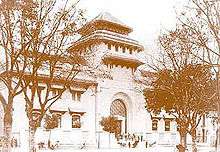Hanoi Medical University
| Đại Học Y Hà Nội | |
|
Indochina Medical College | |
Former names | Indochina Medical College |
|---|---|
| Established | 1902 |
| President | A/Prof. Nguyen Duc Hinh |
| Location | Hanoi, Vietnam |
| Website | www.hmu.edu.vn |
Hanoi Medical University (HMU) (Vietnamese: Đại học Y Hà Nội) is the oldest university of Vietnam located in Hanoi. HMU was found in 1902 by French during the French colonisation under the name Indochina Medical College. The first headmaster of HMU was Alexandre Yersin who was the co-discoverer of the bacillus responsible for the bubonic plague or pest, which was renamed in his honour (Yersinia pestis).
History

HMU, originally called Indochina Medical College, was founded in 1902. It was the first modern university in Vietnam, and the second of all universities in Vietnam after the Temple of Literature. It was located in Le Thanh Tong street, next to what was then its practice hospital, 108 Hospital. In 1961, Hanoi University of Pharmacy was spun off from HMU and took residence in the old campus. HMU was moved to a newly built campus in its current address in Ton That Tung street - named after one of its principals, and next to the largest hospital in Hanoi - Bach Mai Hospital. It has also offices in Viet Duc Hospital.
HMU is considered the most famous medical university in Vietnam. The exam to enter the university is very competitive. In the past, it was the only medical university that recruited students in all Vietnam. Until now, it has been the only university which did not apply the priority by regions during the national university entrance exam (i.e.: students in rural or difficult regions, who wish to benefit 'the bonus mark by regions', must apply in other medical universities).
References
Coordinates: 21°00′10″N 105°49′54″E / 21.00278°N 105.83167°E
